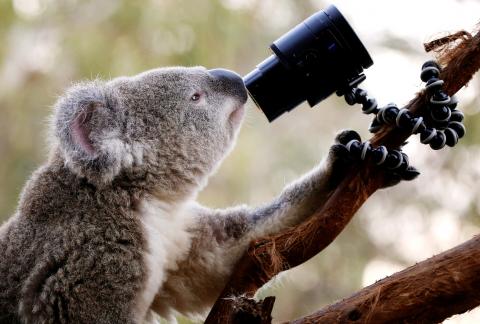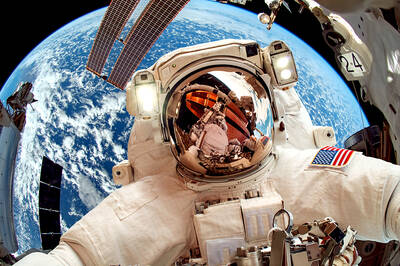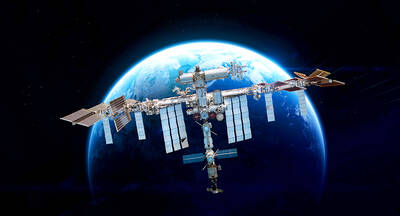Australia’s koalas, their very existence imperiled by disease, bushfires, car strikes, and dog attacks, face a more hopeful future thanks to scientists cracking their genetic code, a study said Tuesday.
A mammoth effort by more than 50 researchers in seven countries uncovered 26,558 koala genes, yielding vital DNA clues for vaccines against diseases such as sexually transmitted chlamydia, which blinds the cuddly critters and leaves them infertile.
“The genome has allowed us to understand the koala immune genes in detail for the first time,” said Rebecca Johnson of the Australian Museum Research Institute, a co-author of the study published in Nature Genetics. “These genes (are) directly contributing to vaccines for koalas,” she told AFP.

Photo: Reuters
照片:路透
The DNA code should also boost koala breeding programs. It revealed that inbreeding was higher among koalas from Victoria and South Australia states than among their cousins from Queensland and New South Wales. The discovery “allows us to make recommendations for how to preserve the populations with high genetic diversity and how animals might be translocated to improve the diversity of inbred populations,” Johnson said.
From between 15 and 20 species some 30 to 40 million years ago, a single species of koala survives in Australia today — some 330,000 individuals in all, most living in protected areas. As few as 43,000 may be left in the wild, down from an estimated 10 million koalas before Europeans began settling Down Under in around 1788. Koala numbers were decimated partly by a thriving pelt trade from the 1870s to the late 1920s. The International Union for Conservation of Nature qualifies the koala’s protection status as “vulnerable”.
Koalas are marsupials — mammals that raise their young in a tummy pouch. Born without an immune system, the koala joeys are heavily dependent on their mothers’ milk. A key discovery resulting from the genome sequencing was the discovery of koala-specific milk proteins that may also have “powerful antibiotic properties ... (that are) really effective against bacteria and fungi.” “So we think one day we could develop antibiotics for humans and other animals straight out of the koala’s pouch,” the study’s co-author Katherine Belov of the University of Sydney told AFP. “And the implications for that are huge, because of course antibiotics resistance is on the rise and we are seeing more and more novel bacteria emerge that are resistant to all drugs on the market.”
Koalas’ unusual diet consists mainly of eucalyptus leaves, which would be toxic for most animals and are low in calories, meaning the fluffy “bears” have to eat a lot and rest often. The new study identified genes responsible for liver detoxification that likely permitted koalas to become such dietary specialists, thus avoiding competition for food with other animals. Unfortunately, their pickiness now adds to the survival pressure, with eucalyptus trees cleared for farmland or for urban construction. Global warming, experts say, will further raise the risk of devastating forest fires and tree death.
The koala genome is bigger than the human genome, with about 20,000 genes. It is the most complete genome yet sequenced for any marsupial, of which there are about 300 species, the researchers said.
(AFP)
週二的一份研究指出,多虧科學家解開遺傳密碼,澳洲無尾熊生存陷於疾病、林地野火、車禍撞擊,以及犬隻攻擊的情況,終於看到更有希望的未來。
來自七個國家、超過五十名研究人員的龐大努力,揭露出無尾熊兩萬六千五百五十八個基因,為疫苗帶來重要的DNA線索,以對抗性傳染的衣原體等疾病。這種讓人想摟摟抱抱的小動物會因為衣原體感染而失明,並失去生育能力。
澳洲博物館研究所的蕾貝卡‧強森指出:「這組基因體讓我們首次詳細了解無尾熊的免疫基因。」強森是這份發表於期刊《自然遺傳學》研究的共同作者,她向法新社表示:「這些基因直接促成無尾熊的疫苗。」
DNA密碼也有望推動繁殖無尾熊的計畫:DNA顯示,維多利亞州和南澳大利亞州無尾熊近親繁殖的情況較昆士蘭州與新南威爾斯州來得頻繁。這項發現「讓我們能夠針對族群數量保護、維持高度基因多樣性,以及如何重新配置族群來改善近親繁殖等面向,提出相應建議。」
從大約三千萬到四千萬年前的十五到二十個物種中,無尾熊這個單一物種今日在澳洲存活下來──總數約三十三萬隻,大多居住於保護區中。一七八八年前後,當歐洲人落腳於澳洲後,估計原有一千萬隻野生的無尾熊,數量銳減為四萬三千隻。無尾熊遭大規模撲殺的部分原因,來自於一八七○年代到一九二○年代晚期猖獗的毛皮貿易。國際自然保育聯盟(IUCN)將無尾熊的保育地位列為「易危」的程度。
無尾熊屬於有袋目──亦即在腹部育兒袋養育幼獸的哺乳類。無尾熊幼獸出生時沒有免疫系統,非常仰賴母親的乳汁。基因體測序帶來關鍵的發現:無尾熊特有的乳蛋白可能擁有「強力的抗菌屬性,能夠有效對抗細菌和真菌。」雪梨大學的凱瑟琳‧貝洛夫是該研究的另一位共同作者,她向法新社表示:「所以我們在想,人類有一天能夠直接從無尾熊的育兒袋中培養出用於人類和其他動物的抗生素。」貝洛夫指出:「這個涵義相當深遠,畢竟對抗生素的抗藥性愈趨升高,我們也看到愈來愈多能抵抗市面上所有藥物的新細菌浮現。」
無尾熊的特殊食物主要由尤加利樹葉組成,這對大部分動物而言是有毒性的,且卡路里含量低,也就是說,這些毛茸茸的「熊熊」必須吃很多、睡很多。這份新研究辨識出負責肝臟解毒作用的基因,可能就是讓無尾熊成為如此單一飲食的專家,也因而避免和其他動物競爭食物。不幸的是,隨著尤加利樹因農田或都市建設而遭砍除,無尾熊的挑食現在造成更沉重的生存壓力。專家表示,全球暖化會進一步增加毀滅性森林火災和樹木死亡的風險。
無尾熊的基因體較人類龐大,後者約有兩萬個基因。研究人員表示,該成果是目前對有袋目動物進行測序獲得的最完整基因體,有袋目動物約有三百種。
(台北時報章厚明譯)

A: Wow, Les Miserables Staged Concert Spectacular is visiting Taiwan for the first time. B: Isn’t Les Miserables often praised as one of the world’s four greatest musicals? A: Yup. Its concert is touring Taipei from tonight to July 6, and Kaohsiung between July 10 and 27. B: The English version of the French musical, based on writer Victor Hugo’s masterpiece, has been a huge success throughout the four decades since its debut in 1985. A: The musical has never toured Taiwan, but going to the concert sounds like fun, too. A: 哇,音樂劇《悲慘世界》紀念版音樂會首度來台巡演! B: 《悲慘世界》……它不是常被譽為全球四大名劇之一嗎? A: 對啊音樂會將從今晚到7月6日在台北演出,從7月10日到27日在高雄演出。 B: 這部法文音樂劇的英文版,改編自維克多雨果的同名小說,自1985年首演以來,在過去40年造成轟動。 A:

Some 400 kilometers above the Earth’s surface, the “International Space Station” (ISS) operates as both a home and office for astronauts living and working in space. Astronauts typically stay aboard the station for up to six months and engage in groundbreaking research projects in various fields, such as biology, physics and astronomy. These projects help scientists understand life in space and contribute to advancements that benefit people on Earth. The ISS has experienced significant growth since construction began in 1998. The station’s design and assembly represent an extraordinary international collaboration among Canada, the European Union, Japan, Russia and the United States.

A: While hit musical Les Miserables’ concert tour kicks off, South Korean drama Squid Game 3 will be back at the end of this month. B: New Taiwanese dramas The World Between Us 2 and Zero Day Attack have also gained attention. A: I heard that Zero Day Attack is a story about the Chinese Communist Party’s People’s Liberation Army trying to attack Taiwan by force. B: The drama’s subject is so sensitive that it has sparked a lot of controversy in society. A: I just hope that such a horrible story will never happen in

Continued from yesterday(延續自昨日) https://www.taipeitimes.com/News/lang Living on the ISS is challenging due to the absence of gravity. Astronauts must strap themselves into sleeping bags to prevent floating away while they sleep. They also spend about two hours exercising daily using specialized equipment. Despite this, microgravity can cause muscle loss, bone density reduction and cardiovascular changes. As a result, astronauts require extensive rehabilitation upon their return to Earth. In spite of these difficulties, astronauts often describe their experience on the ISS as life-changing. One of the most awe-inspiring aspects of living aboard the space station is the unparalleled view of Earth. Traveling at